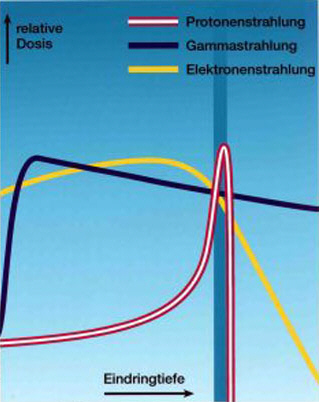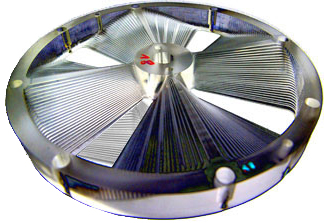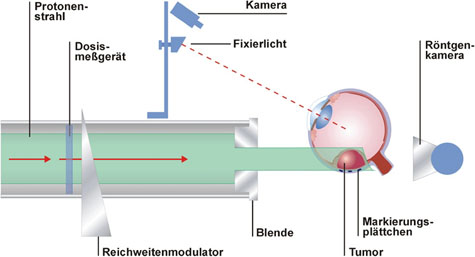Proton Therapy
How does proton therapy work?
Further information concerning:
Depth dose distribution of proton beams
For quality assurance, measurements of the proton dose distribution are repeatedly carried out with a special water phantom, to ensure the correct dose deposition in human tissue.
A mono-energetic proton beam travelling through water presents a depth dose distribution that is shaped like a narrow mountain hill with a steep fall-off at its end, the so-called Bragg-curve.
Due to the narrow Bragg-peak, yet this dose distribution cannot be used for therapy. In order to generate a dose distribution ready for therapy that has to be homogeneous over a certain depth, the proton beam has primarily to be flattened.
Figure right: Comparison between different qualities of radiation. The depth dose distribution of electron beams and X-rays, which are both used in conventional radiotherapy, differs significantly from that of high-energy proton beams. The steep dose fall-off of the latter allows the radiotherapist to administer the dose precisely to the tumour region.
Principles of beam modulation
Flat depth dose distributions can be provided, for example, by a rotating Plexiglas wheel with a variable thickness. Once this wheel is inserted into the beam, it creates a time-averaged depth dose with an appropriate dose plateau of pre-defined length.
The single Bragg-curves that result from different penetration lengths in Plexiglas are shifted in range and intensity, together they sum up to an averaged "modulated" proton depth dose curve.
Range and modulation length of the proton beam have to be adjusted for irradiation so that the tumour is covered by the homogeneous dose plateau.
Shape of the irradiation field
The tumour outline not only defines the shape of the depth dose curve to be applied, but sets the lateral margin of the proton beam that is directed to the patient's eye, too. For each patient, an individual brass collimator is computed and produced to shield the healthy parts of the eye.



